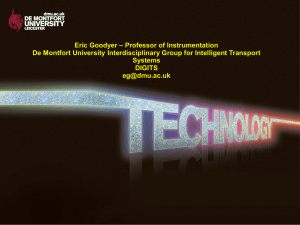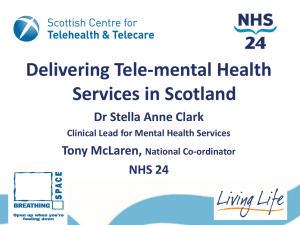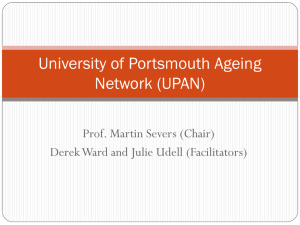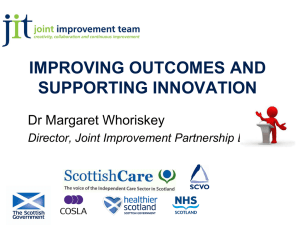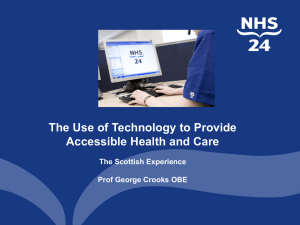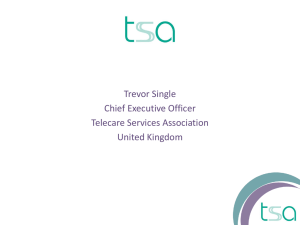Telecare Assessor Training
advertisement
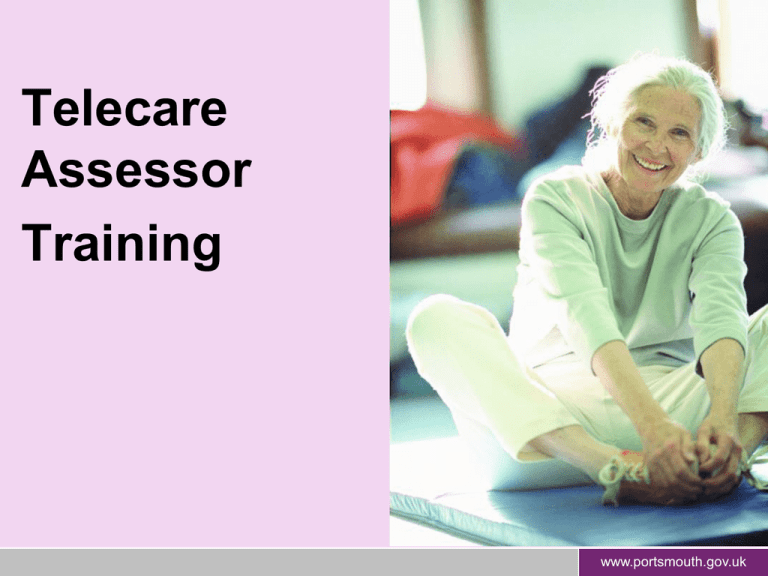
Telecare Assessor Training www.portsmouth.gov.uk What is Telecare? • Telecare is the remote or enhanced delivery of health and social care to people in their own homes, using a combination of alarms, sensors and other equipment to help people live independently. • Telecare can raise a call for help in emergency situations, such as a fall, a fire or a flood, as well as monitoring lifestyle changes over time. • Telecare is not intended to replace human contact but is designed to support safety, independence and well-being of users, and to support carers. 2 www.portsmouth.gov.uk Major benefits over traditional alarm services • Passive system, doesn’t need the user to initiate the alarm call • Environmental as well as person-centred • Preventative as well as reactive 3 www.portsmouth.gov.uk Assistive technology Assistive technology = A generic term for any device or equipment which enables someone to undertake an activity of daily living with greater safety and/or independence. The definition now extended from equipment such as bath seats, wheelchairs and stair lifts, to include newer stand-alone and Telecare home safety and security, lifestyle reassurance and remote vital signs equipment. Stand alone used directly by the person or carer (not linked to alarm monitoring centre) Stand alone examples • Recorded message memo minders • Plug that releases the water in a bath before it overflows if tap left running Telecare automatically sends a signal to an alarm monitoring centre to call for assistance Stand-alone Telecare Telecare examples • Fall detector raises alert even if user unconscious • Door exit monitors that raise alert if person leaves building at inappropriate time What is the difference? www.portsmouth.gov.uk 5 www.portsmouth.gov.uk Telecare System Wireless sensors A L A R M Home Hub Monitoring Centre Response Team www.portsmouth.gov.uk Emergency Response Teams Mobile Warden Telecare Control Centre Relatives & friends Rapid Response Unit Falls pick-up service Duty Social Worker An appropriate response Fire service 24 Hour --Nurse 24 hour Gas fitter Emergency plumber 24 hr. Home Care Police Out-of-hours GP Air ambulance Ambulance www.portsmouth.gov.uk Telecare Characteristics • • • • • • Not appropriate for every person Not a ‘one-size fits all’ solution Person-centred & needs-based, not equipment-led Promotes independence and safety Supported by a robust response infrastructure Integrates into existing practice, process and service provision • Supports health and social care provision • Considers ethical issues 8 www.portsmouth.gov.uk Telecare service integration Entry (Re) assessment of need Care package development Review Social services Telecare service Primary care providers Response Acute care Housing services Telecare prescription & response protocol Equipment suppliers Call handling Social Housing landlords Monitoring 9 Barlow & Curry 2006 Source: Installation and maintenance Home survey Equipment provision www.portsmouth.gov.uk Why use Telecare? 10 www.portsmouth.gov.uk ‘Telecare offers the promise of enabling thousands of older people to live independently, in control and with dignity for longer.’ ‘Telecare is as much about the philosophy of dignity and independence as it is about equipment and services.’ Building Telecare in England DoH July 05 11 www.portsmouth.gov.uk Policy Drivers - DH documents • • • • • • Building telecare in England Our health, our care, our say Putting people first Delivering care closer to home Carers’ Strategy NHS Next stage Review- Primary & Community care (Darzi report) • Supporting people with long-term conditions • Valuing people now • National Dementia Strategy 12 www.portsmouth.gov.uk 13 www.portsmouth.gov.uk How can Telecare be used? 14 www.portsmouth.gov.uk Environment Pop-up plug Flood detector Smoke detector Gas / CO detector Extreme temperature detector Security Barking dog recording PIR-activated external lighting Intruder alert Bogus caller panic button Door / window contacts Video door entry system 16 www.portsmouth.gov.uk Safety Fall detector Bed / chair occupancy sensor Pull cord Water temperature alert Sounder beacon / vibrating alarm Memo minder Door exit monitor – wander alert GPS tracker / locator Social Telecare 24/7 monitoring may reduce need for pop-in visits Need to be aware of need for contact with real people Consider volunteers to visit at home or integrate into community activities Enable meaningful social interaction Interactive systems, via settop box, to provide info on local services, health advice, etc. 18 www.portsmouth.gov.uk QuietCare Lifestyle Monitoring Passive infra red motion sensors, in various rooms of house, send info every few hours to centre, noteworthy changes flagged-up, appropriate action can be taken before crisis develops. Useful for assessment purposes 19 www.portsmouth.gov.uk Health Medication dispenser Epilepsy sensor Enuresis (night-time incontinence) sensor Reminders and coaching by mobile phone (condition management) Remote vital signs monitoring (see next slide) Telehealth peripherals 21 www.portsmouth.gov.uk Telehealth Benefits For users and carers: • • • • • • • • • 22 the right care, in the right place, at the right time regular, consistent monitoring of vital signs avoids crises arising timely, proportionate interventions assisted self-management / patient education in keeping well care closer to home fewer surgery and clinic visits fewer hospital admissions better outcomes www.portsmouth.gov.uk Telehealth Benefits (cont’d) For health services: • Consistent with PCT strategic planning goals, (care closer to the patient, more efficient, pro-active case management of long-term conditions, personalised care, improving health education, improved patient experience, increased numbers of people able to die at home) • better use of GP and other health practitioner time • better prioritisation for intervention - urgent patients can be seen faster • reduced ambulance call-outs • reduced trips to A&E • reduced admissions to hospital • earlier discharge from hospital • high quality & value for money 23 www.portsmouth.gov.uk Development of in-house response service • Since 2009, Portsmouth Rehabilitation and Reenablement Team (PRRT) have provided a night time (9pm to 6am) response service to support Telecare users’ own responders. • They are trained in risk assessment, first aid, moving & handling, use of Mangar Elk (lifting cushion) • They feedback to NHS & social care, to close information loop on fallers 24 www.portsmouth.gov.uk Impact on Local Services • Reducing demand on ambulance services • Preventing unnecessary admissions to hospital and residential care • Supporting earlier discharges from hospital, community rehab • Enabling independence, dignity and choice • Improving preventative services • Supporting carers • Stronger links between health & social care 25 www.portsmouth.gov.uk Cost of Telecare • Charges can be taken into account in financial assessment for care package, as disabilityrelated expense • No cost is made to the customer for stand-alone equipment if identified need during community care assessment. This is currently recharged to Adult Social Care. www.portsmouth.gov.uk Key lessons learnt • The technology is only as good as the infrastructure that supports it • Telecare = 20% technology, 80% people • Telecare must be integrated into existing health and community care • Technology package and response must be tailor-made to individual • Service must be reviewed and adjusted as necessary 27 Referrals for telecare • Individual can self-refer • Carer can refer • Professional can refer using the on line professional referral form on the web site • You can phone on 0800 731 2228 or email: telecare@portsmouthcc.gov.uk for more information. 28 www.portsmouth.gov.uk Useful references • • • • • • • • • 29 www.dhnetworks.org.uk/telecare www.wsdactionnetwork.org.uk www.chubbcommunitycare.co.uk www.tunstallgroup.com/home.aspx www.telemedcare.co.uk www.quietcare.co.uk www.pivotell.co.uk www.atdementia.org.uk www.telecareaware.com www.portsmouth.gov.uk
